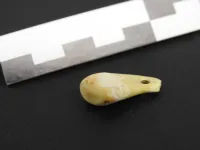(Press-News.org) The need to capture CO2 and transport it for permanent storage or conversion into valued end uses is a national priority recently identified in the Bipartisan Infrastructure Law to move toward net-zero greenhouse gas emissions by 2050.
Now, Northwestern University researchers have worked with an international team of collaborators to create acetic acid out of carbon monoxide derived from captured carbon. The innovation, which uses a novel catalyst created in the lab of professor Ted Sargent, could spur new interest in carbon capture and storage.
“Carbon capture is feasible today from a technical point of view, but not yet from an economic point of view,” Sargent said. “By using electrochemistry to convert captured carbon into products with established markets, we provide new pathways to improving these economics, as well as a more sustainable source for the industrial chemicals that we still need.”
The paper was published today (May 3) in the journal Nature.
Sargent, the paper’s corresponding author, is Northwestern’s Lynn Hopton Davis and Greg Davis Professor of Chemistry at the Weinberg College of Arts and Sciences and a professor of electrical and computer engineering at the McCormick School of Engineering. His team has a track record of using electrolyzers — devices in which electricity drives a desired chemical reaction forward — to convert captured carbon into key industrial chemicals, including ethylene and propanol.
Though acetic acid may be most familiar as the key component in household vinegar, recent University of Toronto Ph.D. recipient Josh Wicks, one of the paper’s four co-lead authors, said this use accounts for only a small proportion of what it’s used for.
“Acetic acid in vinegar needs to come from biological sources via fermentation because it’s consumed by humans,” Wicks said. “But about 90% of the acetic acid market is for feedstock in the manufacture of paints, coatings, adhesives and other products. Production at this scale is primarily derived from methanol, which comes from fossil fuels.”
Lifecycle assessment databases showed the team that for every kilogram of acetic acid produced from methanol, the process releases 1.6 kg of CO2.
Their alternative method takes place via a two-step process: first, captured gaseous CO2 is passed through an electrolyzer, where it reacts with water and electrons to form carbon monoxide (CO). Gaseous CO is then passed through a second electrolyzer, where another catalyst transforms it into various molecules containing two or more carbon atoms.
“A major challenge that we face is selectivity,” Wicks said. “Most of the catalysts used for this second step facilitate multiple simultaneous reactions, which leads to a mix of different two-carbon products that can be hard to separate and purify. What we tried to do here was set up conditions that favor one product above all others.”
Vinayak Dravid, another senior author on the paper and the Abraham Harris Professor of Materials Science and Engineering, is the founding director of the Northwestern University Atomic and Nanoscale Characterization (NUANCE) Center, which allowed the team to access diverse capabilities for atomic- and electronic-scale measurements of materials.
“Modern research problems are complex and multifaceted and require diverse yet integrated capabilities to analyze materials down to the atomic scale,” Dravid said. “Colleagues like Ted present us with challenging problems that stimulate our creativity to develop novel ideas and innovative characterization methods”.
The team’s analysis showed that using a much lower proportion of copper (approximately 1%) compared with previous catalysts would favor the production of just acetic acid. It also showed that elevating the pressure to 10 atmospheres would enable the team to achieve record-breaking efficiency.
In the paper, the team reports a faradic efficiency of 91%, meaning that 91 out of every 100 electrons pumped into the electrolyzers end up in the desired product — in this case, acetic acid.
“That’s the highest faradic efficiency for any multi-carbon product at a scalable current density we’ve seen reported,” Wicks said. “For example, catalysts targeting ethylene typically max out around 70% to 80%, so we’re significantly higher than that.”
The new catalyst also appears to be relatively stable: while the faradic efficiency of some catalysts tend to degrade over time, the team showed that it remained at a high level of 85% even after 820 hours of operation.
Wicks hopes that the elements that led to the team’s success — including a novel target product, a slightly increased reaction pressure, and a lower proportion of copper in the catalyst — inspire other teams to think outside the box.
“Some of these approaches go against the conventional wisdom in this field, but we showed that they can work really well,” he said. “At some point, we’re going to have to decarbonize all the elements of chemical industry, so the more different pathways we have to useful products, whether it’s ethanol, propylene or acetic acid, the better.”
The research was funded by the National Key R&D Program of China (grant number 2022YFC2106000, 2022YFA1505100 and 2020YFA0715000), the National Natural Science Foundation of China (grant numbers 11874164, 52006085, BE3250011, 52127816, 51832004, 51972129 and 52272202) and the Innovation Fund of Wuhan National Laboratory for Optoelectronics. Also supporting is the China Postdoctoral Science Foundation (grant numbers 2019TQ0104 and 2020M672343), the) and Shanghai Jiao Tong University (grant number WH220432516). The Natural Sciences and Engineering Research Council of Canada (NSERC) Discovery program (grant number RGPIN-2017-06477) and the Ontario Research Fund (grant number ORF-RE08-034) provided funding. Finally, the Marsden Fund Council for Government funding (grant number 21-UOA-237) and the Catalyst: Seeding General Grant (grant number 22-UOA-031-CGS), managed by the Royal Society Te Apārangi funded the research.
This work made use of the EPIC facility of Northwestern University’s NUANCE Center, which has received support from the SHyNE Resource (grant number NSF ECCS-2025633), the IIN and Northwestern’s MRSEC programme (grant number NSF DMR-1720139).
END
New catalyst transforms carbon dioxide into sustainable byproduct
The carbon capture method works by using carbon to make acetic acid
2023-05-03
ELSE PRESS RELEASES FROM THIS DATE:
Virtual consulting can significantly cut carbon footprint in health care, new study suggests
2023-05-03
Virtual consulting is a new and emerging contributor to environmentally sustainable health care, according to findings of new research published in the Journal of Medical Internet Research.
The COVID-19 pandemic has accelerated the shift to virtual consulting, leading to its growing use. As health systems across the world strive to achieve net-zero carbon emissions, a critical question arises: what is the impact of virtual consulting on environmental sustainability in health care? A new research study led by Sara Shaw and team aims to address this ...
USC Verdugo Hills Hospital nationally recognized with first ‘A’ hospital safety grade
2023-05-03
LOS ANGELES — For the first time, USC Verdugo Hills Hospital (USC-VHH) earned an “A” Hospital Safety Grade from The Leapfrog Group, an independent national watchdog organization, for achieving the highest national standards in patient safety. This achievement places USC-VHH among top tier hospitals in the nation for safety and quality.
“Our entire staff is dedicated to improving and upholding the highest standards of patient care,” said Mary Virgallito, MSN, RN, chief quality officer at USC-VHH. “This score reinforces our ...
In a first, astronomers spot a star swallowing a planet
2023-05-03
As a star runs out of fuel, it will billow out to a million times its original size, engulfing any matter — and planets — in its wake. Scientists have observed hints of stars just before, and shortly after, the act of consuming entire planets, but they have never caught one in the act until now.
In a study that will appear in Nature, scientists at MIT, Harvard University, Caltech, and elsewhere report that they have observed a star swallowing a planet, for the first time.
The ...
Traces from the past
2023-05-03
Artefacts made of stone, bones or teeth provide important insights into the subsistence strategies of early humans, their behavior and culture. However, until now it has been difficult to attribute these artefacts to specific individuals, since burials and grave goods were very rare in the Palaeolithic. This has limited the possibilities of drawing conclusions about, for example, division of labor or the social roles of individuals during this period.
In order to directly link cultural objects to specific individuals and thus gain deeper insights into Paleolithic ...
New tusk-analysis techniques reveal surging testosterone in male woolly mammoths
2023-05-03
Graphics // Video
Traces of sex hormones extracted from a woolly mammoth's tusk provide the first direct evidence that adult males experienced musth, a testosterone-driven episode of heightened aggression against rival males, according to a new University of Michigan-led study.
In male elephants, elevated testosterone during musth was previously recognized from blood and urine tests. Musth battles in extinct relatives of modern elephants have been inferred from skeletal injuries, broken tusk tips and other indirect lines of evidence.
But the new study, scheduled ...
Evaluation of Waning of SARS-CoV-2 Vaccine–Induced Immunity
2023-05-03
About The Study: The findings of this systematic review and meta-analysis of secondary data from 40 studies suggest that the effectiveness of COVID-19 vaccines against laboratory-confirmed Omicron or Delta infection and symptomatic disease rapidly wanes over time after the primary vaccination cycle and booster dose. These results can inform the design of appropriate targets and timing for future vaccination programs.
Authors: Piero Poletti, Ph.D., of the Bruno Kessler Foundation in Trento, Italy, is the corresponding author.
To access the embargoed study: Visit our For The Media website at this ...
Researchers capture elusive missing step in the final act of photosynthesis
2023-05-03
Menlo Park, Calif. – Photosynthesis plays a crucial role in shaping and sustaining life on Earth, yet many aspects of the process remain a mystery. One such mystery is how Photosystem II, a protein complex in plants, algae and cyanobacteria, harvests energy from sunlight and uses it to split water, producing the oxygen we breathe. Now researchers from the Department of Energy’s Lawrence Berkeley National Laboratory and SLAC National Accelerator Laboratory, together with collaborators from Uppsala University and Humboldt University and other institutions have succeeded in cracking a key secret of Photosystem II.
Using SLAC’s Linac Coherent Light ...
Association between depression and physical conditions requiring hospitalization
2023-05-03
About The Study: In this study that included 240,000 individuals, the most common causes of hospitalization in people with depression were endocrine, musculoskeletal, and vascular diseases, not psychiatric disorders. These findings suggest that depression should be considered as a target for the prevention of physical and mental disease.
Authors: Philipp Frank, Ph.D., of University College London, is the corresponding author.
To access the embargoed study: Visit our For The Media website at this link https://media.jamanetwork.com/
(10.1001/jamapsychiatry.2023.0777)
Editor’s ...
Astronomers witness star devouring planet: possible preview of the ultimate fate of Earth
2023-05-03
By studying countless stars at various stages of their evolution, astronomers have been able to piece together an understanding of the life cycle of stars and how they interact with their surrounding planetary systems as they age. This research confirms that when a Sun-like star nears the end of its life, it expands anywhere from 100 to 1000 times its original size, eventually engulfing the system’s inner planets. Such events are estimated to occur only a few times each year across the entire Milky Way. Though past observations have confirmed the aftermath of planetary engulfments [1], ...
Discovery suggests route to safer pain medications
2023-05-03
Strategies to treat pain without triggering dangerous side effects such as euphoria and addiction have proven elusive. For decades, scientists have attempted to develop drugs that selectively activate one type of opioid receptor to treat pain while not activating another type of opioid receptor linked to addiction. Unfortunately, those compounds can cause a different unwanted effect: hallucinations. But a new study led by Washington University School of Medicine in St. Louis has identified a potential route ...
LAST 30 PRESS RELEASES:
How does age affect recovery from spinal cord injury?
Novel AI tool offers prognosis for patients with head and neck cancer
Fathers’ microplastic exposure tied to their children’s metabolic problems
Research validates laboratory model for studying high-grade serous ovarian cancer
SIR 2026 delivers transformative breakthroughs in minimally invasive medicine to improve patient care
Stem Cell Reports most downloaded papers of 2025 highlight the breadth and impact of stem cell research
Oxford-led study estimates NHS spends around 3% of its primary and secondary care budget on the health impacts of heat and cold in England
A researcher’s long quest leads to a smart composite breakthrough
Urban wild bees act as “microbial sensors” of city health.
New study finds where you live affects recovery after a hip fracture
Forecasting the impact of fully automated vehicle adoption on US road traffic injuries
Alcohol-related hospitalizations from 2016 to 2022
Semaglutide and hospitalizations in patients with obesity and established cardiovascular disease
Researchers ‘listen in’ to embryo-mother interactions during implantation using a culture system replicating the womb lining
How changing your diet could help save the world
How to make AI truly scalable and reliable for real-time traffic assignment?
Beyond fragmented markets: A new framework for efficient and stable ride-pooling
Can shape priors make road perception more reliable for autonomous driving?
AI tracks nearly 100 years of aging research, revealing key trends and gaps
Innovative techniques enable Italy’s first imaging of individual trapped atoms
KIER successfully develops Korea-made “calibration thermoelectric module” for measuring thermoelectric device performance
Diversifying US Midwest farming for stability and resilience
Emphasizing immigrants’ deservingness shifts attitudes
Japanese eels, climate change, and river temperature
Pusan National University researchers discover faster, smarter heat treatment for lightweight magnesium metals
China’s 2024 Gastroenterology Report: marked progress in endoscopy quality and disease management
Pusan National University researchers uncover scalable method for ultrahigh-resolution quantum dot displays
Researchers use robotics to find potential new antibiotic among hundreds of metal complexes
Gut bacteria changes at the earliest stages of inflammatory bowel disease
Scientists develop new way to “listen in” on the brain’s hidden language
[Press-News.org] New catalyst transforms carbon dioxide into sustainable byproductThe carbon capture method works by using carbon to make acetic acid




